
Salvia rosmarinus, commonly known as rosemary, is a shrub with fragrant, evergreen, needle-like leaves and white, pink, purple, or blue flowers, native to the Mediterranean region. Until 2017, it was known by the scientific name Rosmarinus officinalis, now a synonym.
Salvia venulosa is a perennial plant that is native to a very small region of the Western Cordillera in Colombia. It grows at 1,500 to 2,000 m elevation in deeply shaded wooded gullies. S. venulosa grows less than 1 metre (3.3 ft) tall, with narrow ovate leaves that are 6 to 9 cm long and 3 centimetres (1.2 in) wide, and violet on the underside. The flower is an unusual wine-red color.
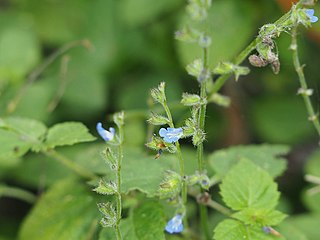
Salvia misella, commonly known as tropical sage, is an annual herb growing throughout tropical America, often found in semi-arid regions on disturbed bushy ground, from sea level to 2,200 metres (7,200 ft). It is similar and perhaps closely related to Salvia occidentalis, with a longer calyx and a 5 millimetres (0.20 in) blue flower.
Salvia rubriflora is a perennial clump forming undershrub endemic to Colombia, growing on exposed grassy banks, near streams, and in dry bushland at elevations from 2,600 to 3,000 m. It is an uncommon plant, most often found at the Cundinamarca-Boyaca border.
Salvia tolimensis is a perennial shrub endemic to a very small region in Colombia (Tolima) growing on streamsides, scrublands, and forest edges in wet conditions at 2,400 to 3,500 m elevation. The plant is a vigorous undershrub, about 1 metre (3.3 ft) high, with narrow ovate leaves that are 6 to 10 cm long and 2.5 to 4 cm wide. The purple flowers are 2.2 to 2.5 cm long.
Salvia funckii is a perennial shrub native to Colombia, growing on rocky slopes in cloud forest from 2,000 to 2,800 m elevation. The plant grows up to 3 m (9.8 ft) tall, with decumbent or ascending stems, and triangular-hastate leaves. The blue flowers are 2.5 to 3 cm long.
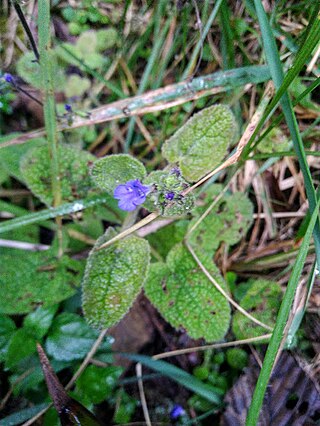
Salvia palifolia is a decumbent perennial herb native to Colombia and western Venezuela, growing in grassland, cloud forest clearings, streamsides, and rocky outcrops from 1,600 to 3,500 m elevation. The 3 to 4 cm long green leaves are hastate or cordate; the blue flowers are 5 to 6 mm long.
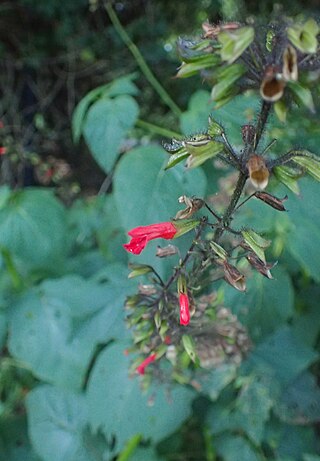
Salvia orthostachys is a perennial shrub endemic to Colombia, growing in dry country on roadsides, rocky banks, and stony bushland. The plant reaches up to 1.5 m (4.9 ft) high, with leaves that are hairy on both surfaces. The red flower is up to 2 cm (0.79 in) long, with a short upper lip.
Salvia nubigena is a perennial undershrub endemic to a very small region in the Rio Concavo Valley in Colombia. It if found on rough bushland on boulder covered slopes, growing at elevations from 3,500 to 3,800 m.
Salvia cyanotropha is a rare and little known perennial Salvia that is endemic to the Ocaña region and the Sierra Nevada de Santa Marta in Colombia. It is found in dryland gullies at 200 to 1,800 m elevation.
Salvia angulata is a herbaceous perennial native to the Caribbean coast from Panama through Colombia to Venezuela. It grows on the sides of streams and in wet forests, at 450 to 1,500 m elevation.
Salvia cuatrecasana is a perennial shrub that is endemic to a few small areas in Colombia, growing at 2,800 to 3,500 m elevation on roadsides, streamsides, and disturbed areas.
Salvia falcata is a perennial shrub that is endemic to a very small area in NW Cundinamarca in Colombia, growing in dry bushland in a steep river valley at around 1,000 m (3,300 ft) elevation—unusually low for red-flowered salvias.
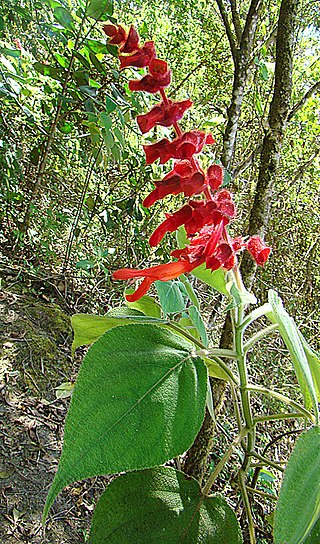
Salvia libanensis is a perennial shrub that is endemic to the northwestern slopes of the Sierra Nevada de Santa Marta in Colombia, growing at elevations between 2,000 to 2,200 m. S. libanensis is a vigorous and spectacular plant reaching 3 m (9.8 ft) tall, with ovate leaves that are 7 to 12 cm long and 3 to 8 cm wide, hairy on both surfaces, with a paler underside. The inflorescence is of terminal racemes, with a 6 cm (2.4 in) red corolla.
Salvia chicamochae is an annual herb that is endemic to the Chicamocha canyon, in the far north of Boyacá in Colombia. It is found at 1,200 to 1,800 m elevation, on steep rocky slopes, in open arid bushland.
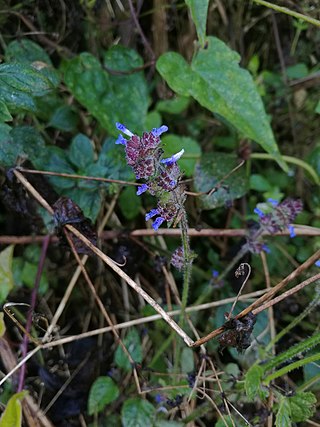
Salvia lasiocephala is an annual herb that is broadly distributed throughout the tropical Americas. It grows up to 60 cm (24 in) high, with leaves that are long-petiolate ovate-triangular, and 2.5 to 4 cm long and wide. The inflorescence of terminal racemes has flowers with a pink to pale lilac or blue corolla that is 5 mm (0.20 in) long.
Salvia melaleuca is a perennial undershrub that is endemic to the north central region of the Eastern Cordillera in Colombia. It is a close relative of S. rubescens, with a villous and much larger corolla than that species. Salvia melaleuca grows approximately 0.5 to 2.5 m high, has a red corolla that is 3.5 to 4.5 cm long, with the upper lip typically 9 mm (0.35 in) long but sometimes up to 15 mm (0.59 in).
Salvia macrostachya is a rare herb native to Ecuador and southern Colombia, with no specific information about its native habitat. A woody, clump-forming plant, it grows up to 4 metres (13 ft) high on thick stems, with broadly ovate leaves that are approximately 8 to 12 cm long and wide. The inflorescence is of very dense terminal racemes that are 10 to 30 cm long. The blue corolla is approximately 2.5 cm (0.98 in) in long.
Salvia pauciserrata is a variable and widely distributed species of Salvia native to Peru, north to Venezuela and Costa Rica. It is found in a wide variety of habitats. It reaches 1 to 2 m tall. The inflorescence is of terminal racemes, with a large red corolla that is 2.5 to 4 cm long.

Ledol is a poisonous sesquiterpene that can cause cramps, paralysis, and delirium. Caucasian peasants used Rhododendron plants for these effects in shamanistic rituals.







